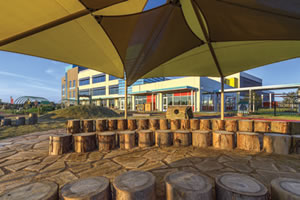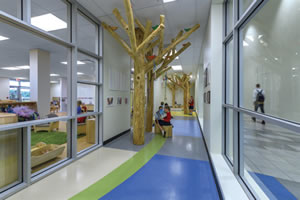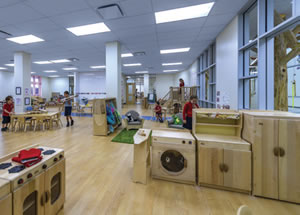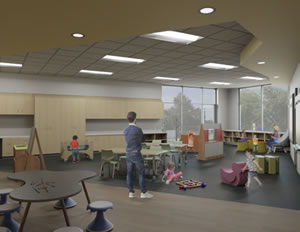5 Building Blocks of Early Childhood Design

PHOTO BY G. LYON PHOTOGRAPHY
For human beings, learning is
as fundamental as life itself. From the
moment we are born up through age
three, our brains create 700 new neural
connections each second. A quality education
during early childhood is proven
to have life-long benefits, academic
achievement being chief among these.
But while early childhood education impacts
life-long learning, the ways we learn
change dramatically over time. The fact is,
early childhood students are in a very different
stage of development compared to their
elementary school peers. And the different
ways young students learn demand a very
different type of learning environment —
one built on the foundational elements of:
Sensory Learning, Movement, Imagination,
Nature and Empathy.
1 SENSORY LEARNING
In the rush to
prepare children for success in kindergarten,
we too often turn our preschools and
early learning centers into mini elementary
schools. However, simply providing
smaller tables and chairs meets only a few
of our youngest learners’ needs.

PHOTO BY G. LYON PHOTOGRAPHY
Active Learning. High-quality outdoor
learning spaces are exceptionally important
to early childhood education.
“From ages zero to three, children are exclusively sensory learners,” says Gabriella
Rowe, head of school at The Village
School in Houston, Texas. “They learn
through experiences like taste, smell and
touch. The simple act of tasting the difference
between sweet and sour food creates
new pathways in the brain.”
According to Rowe, designing for
sensory learning means focusing on the
student experience. “Build some nooks,”
she says. “Maybe it’s a little garden.
Maybe it’s a science corner. Maybe it’s a
simple window with a view to the outside
world. Teachers will take advantage of
these spaces and students will love them.”
Creativity is key when it comes to
designing for the student experience. At
the new West Point Elementary School, located
on the West Point Military Academy
in New York, early childhood spaces are
designed with kitchen hubs in each neighborhood.
These cozy areas are perfect for
snack time, while allowing children to
observe food as it is being cooked. Hard
counter tops and durable flooring let
students participate in food preparation,
without fear of making a mess.
Sensory development in young
children also has significant implications
for the scale of learning environments.
“Don’t put a small child in a large
space,” says Rowe. “From a sensory
standpoint, it is impossible for a small
child to tell where the walls are in a big
space. They need smaller spaces to truly
understand their environment.”

PHOTO BY G. LYON PHOTOGRAPHY
Placemaking. Scale is important, even
outdoors. Create spaces to give every student
a sense of place.
Creating smaller spaces often flies
in the face of limited budgets. In school
construction, straight lines are less
expensive; angles and curves cost more.
If you are on a tight budget, consider
breaking down the space through a
variety of seating options or through
floor patterns that create visual nooks
and gathering spaces. Even these small
investments make a big impact.
2 MOVEMENT
Movement is the second
building block of a great early childhood
environment. The energy shown by young
students is incredible to behold. But according
to research, young children aren’t just
moving to move; they’re moving to learn.
“Young students need to move to develop
their senses,” says Dr. Thomas Mueller, managing
partner of VS America and an expert
on early childhood education. “Never design
an early childhood classroom to be filled
with stuff. Give students space to move. Fifty
percent of the room should be furnished and
fifty percent should be open.”

PHOTO BY G. LYON PHOTOGRAPHY
Outside In. Corridors can become places to
explore Nature on days when students aren’t able
to venture outside.
Designing for movement takes on very
different forms, depending on the curriculum
and budget. At British International School
of Houston in Katy, Texas, the Early Years
Center classrooms are open spaces defined by
a variety of learning stations and experiences.
Students flow seamlessly between space for
art, music, dancing, building, gathering and
outdoor exploration. The flexibility of the
open environment allows British School faculty
to change the space to reflect the evolving
educational needs of young learners.
More traditional early childhood schools
include smaller classrooms with fixed walls.
In these environments, movement is still
possible. Rather than creating a pod with
four identical classrooms, consider designing
each classroom to serve a different purpose:
a space to get messy, a space for life skills,
and so on. Then allow students to move from
space to space during the day.
Dr. Mueller stresses that movement should
occur even in smaller spaces. “Children love
to work on the floor,” he says. “Don’t just give
students access to different learning experiences.
Let them have the same experience
in different ways, whether they are sitting,
standing or lying on the floor.”

PHOTO BY G. LYON PHOTOGRAPHY
Room to Move. Open areas with a variety of
learning experiences allow young students to be
active and to follow their imagination.
During planning and design, the need for
movement must be balanced with curriculum
requirements. Public schools are increasingly
directed to focus on pre-reading and
technology skills, even at the youngest ages.
When addressing these mandates, create a
mix of spaces. Designing for exploration and
academic achievement go hand-in-hand, as
long as students have space to move!
3 IMAGINATION
No one questions
that imagination is an important part of a
child’s early education. But too often, the
physical environment is a barrier to imagination,
rather than a catalyst for it.
Dr. Mueller warns against designing early
childhood spaces with a lavish theme. “Children
don’t want a world that is given to them,”
he says. “They want to build their own world.
It is more interesting for them to construct
and create their own environment.”
Rowe agrees wholeheartedly with this
sentiment. “Young children learn through
process, not product,” she says. “Instead
of providing toy castles, we want them to
build their own castles. If you give a child
something prefabricated, there is no process
and there is no learning.”

PHOTO BY G. LYON PHOTOGRAPHY
Student-Centered. Playful elements encourage
students to explore the world around them.
To allow children to shape their environment,
show restraint during design. The television
version of a preschool room, decorated
in bright primary colors and featuring lavish
graphic themes, will actually limit imagination.
Instead, be strategic with where color is
placed, and leave plenty of blank space. Many
early childhood schools opt for a neutral color
scheme throughout the building. Some educators
even so far as to make sure the rugs are
monochromatic. The goal of design restraint
is to create a canvas for student artwork. In
this type of environment, the child’s work is
on display, not the designer’s.
While restraint during design is a
good quality, playful elements still have
their place. At the new Pike Early Learning
Center in Indianapolis, Ind., animalthemed
wall graphics in the corridors assist
with wayfinding. The graphics support
the school’s emphasis on connectedness
and ground children in a sense of place.
A memorable animal image by the main
entrance lets a child know, “This is where
mom or dad picks me up each day.”
At the same time, the design for Pike
Early Learning Center places a strong
emphasis on student work. The walls in the
school’s main corridor are purposefully left
blank, except for a large tackable surface
for displaying student artwork. The art will
greet students each morning as they arrive
at school and journey to their classrooms.
4 NATURE
Connections between indoor and
outdoor spaces are critical components of early
childhood education. Through creative design,
young children are able to learn from nature, no matter what their geography or climate.

PHOTO BY G. LYON PHOTOGRAPHY
Inspired Design. Dramatically-shaped spaces
encourage the imagination and promote
physical activity.
Whether you are building new or renovating, make sure to
prioritize outdoor space. Playgrounds offer a variety of opportunities
for sensory learning and the development of large motor skills.
Make your playground multi-faceted and offer space for rolling
down hills, digging in the sand, riding tricycles, exploring nature
or taking care of plants or animals.
When designing for indoor and outdoor connections, it is important
to clarify expectations for student movement. Will children be
able to move spontaneously from space to space? Should doors leading
to secure play areas have latches? Answering these questions will
allow designers to maximize learning opportunities while meeting
expectations for security and oversight.
When outdoor learning is not possible, consider bringing nature
inside. British International School of Houston has large wooden
trees in the corridors just outside the Early Years Center. The trees
provide an exciting place for students to gather on the rare days they
cannot venture outdoors. Other design opportunities include the
use of natural materials in furniture and furnishings. “In our digital
world, so much of what a child experiences is plastic or metal,” says
Dr. Mueller. “Young students love to feel wood and stone — materials
that connect them to the authentic world.”
5 EMPATHY
Empathy is the final building block of early childhood
design, and it is the most important factor of all. Clair Wain,
director of Early Years education for British International School
of Houston, recommends starting the design process by clarifying
your beliefs about children and about childhood.
“Each choice springs from a different understanding of a child’s
place in the classroom and the teacher’s role,” she says. “I would
suggest that the first step in designing a new space for young children
is to consider:
- Who is a child?
- What is childhood?
- How do we learn?
- How do children learn?
- What is the meaning of education?
Once you are clear in your beliefs about children, then you will
be able to design your space in accordance with your school community’s
values.”
Wain also recommends close collaboration between designers
and the teachers who will work in the space. Teachers are especially
helpful, she says, in discussing practicalities such as the height of
sinks and the number and placement of toilets.
Collaboration between educators and designers has always
resulted in optimal spaces for learning, but there are also exciting
lessons to be learned from other building types. The GAP Kids®
stores with their separate doors for adults and children are an
excellent example of child-centered design. Giving young students
an entrance all their own says, “this is a place for you.” Children’s
museums, with their emphasis on exploration and discovery, are
another source of inspiration.
BUILDING BLOCKS FOR LIFELONG SUCCESS
Advocates for
high-quality early childhood education point to improved test scores,
among other benefits. Yet while better performance on tests is a worthy
goal, it should not be the sole criteria for evaluating the effectiveness of
early childhood environments. Designing for sensory learning, movement,
imagination, nature and empathy leads to facilities focused on a
broader view of the learning experience for each child.
In fact, Wain suggests evaluating your space from a unique
perspective. She asks, “In your current school or future school, how
would you respond to a child who wonders:
- Do I belong here?
- Is this place safe for me?
- Do you know me?
- Will you let me fly?”
The answers to these questions are the true measure of exceptional
early childhood facilities.
This article originally appeared in the issue of .